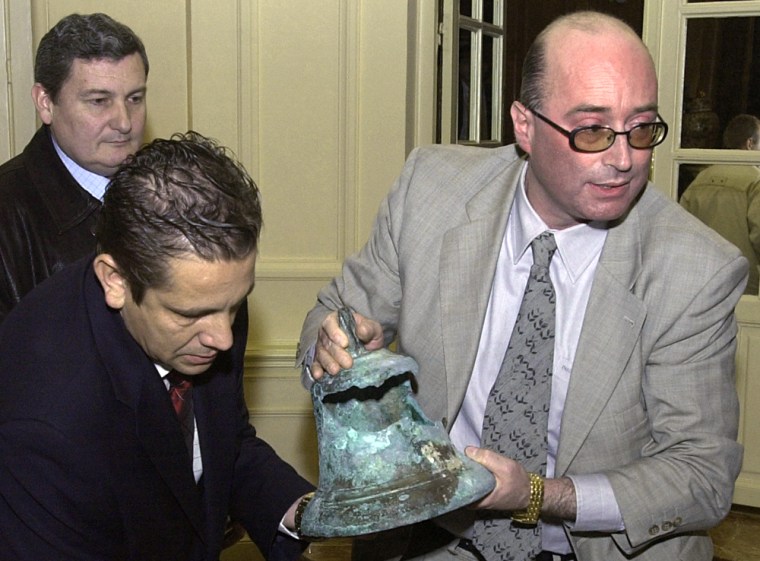The bronze bell that rang out from Christopher Columbus’ flagship Santa Maria when the explorer first spotted America has been returned to Spanish auctioneers after a legal dispute with Portugal, in whose waters the artifact was found, the auction house said Sunday.
In a ruling 10 days ago, a Spanish criminal court rejected Portugal’s claim that the rusty, broken bell — found in 1994 by a diver inside a Spanish galleon in shallow waters just off that country’s coast — had in effect been stolen from Portugal.
The bell, seized by Spanish police in February 2003 at the request of Portugal three days before its planned auction in Madrid, was returned June 11 to the Barcelona-based auction house Gestion de Activos y Subastas, its spokesman David del Val Catala told The Associated Press from Barcelona.
It is sitting inside a safe at a Madrid bank. “We have won the first round,” del Val Catala said.
The 31-pound bell is about 10 inches high, and 10 inches wide at its bottom rim. It is covered with a turquoise-colored residue and has a gaping hole with jagged edges in its upper part. Encrusted in the bottom part is a flat, white seashell the size of a fingernail.
The national news agency Efe said Sunday the bell has been appraised to be worth between $30 million to $60 million. Del Val Catala said that range sounds about right. “It is a piece like no other,” he said.
Now, a Spanish civil court judge has scheduled a July 11 hearing on whether Portugal can still claim the bell. But even if the judge rules in favor of Portugal, its government will have to pay for the artifact. It would be up to the judge to set the price.
Claudio Bonifacio, a Spanish historian specializing in shipwrecks and sunken treasures, says it is the oldest ship’s bell ever recovered and the only known relic from Columbus’ first journey across the Atlantic. It also symbolizes the moment when European settlers first glimpsed the New World.
Del Val Catala said that if and when his company gains full rights to the bell, the auction might be rescheduled for later this year. The Spanish government has the right to match the winning bid and take possession of the bell as part of the country’s historical heritage.
Bidding had been scheduled to start at $1 million at the auction that was thwarted in 2003.
Portugal claims the bell because it was found in Portuguese waters. The auctioneers, acting on behalf of Italian diver Roberto Mazzara, who found it, say the bell is Spanish because it was found inside a Spanish vessel, the San Salvador. The criminal court judge agreed.
“The Santa Maria was and is part of Spain’s historical heritage,” Mazzara said Sunday from his home in Algeciras in southern Spain. “It is absolutely none of Portugal’s business.”
Portuguese officials were not available for comment Sunday
Mazzara, a professional diver, did years of detective work to prove the bell is the one that rang out when Columbus and his three-ship flotilla arrived in America after their historic voyage in 1492.
Mazzara found it amid the wreckage of the gold-laden Spanish galleon San Salvador, which sank off Portugal in 1555 while returning to Spain from the island of Hispanolia.
He and academics argue that Columbus had used the bell at a fortress he ordered built on Hispaniola, until it was decided the artifact was so valuable it should be shipped back to Spain.
Mazzara and the auction house say they cannot prove beyond doubt that the bell is the real thing, but insist it is.
Every available scientific study has been carried out on the bell and on historical documents surrounding the shipwreck, and they all point to the bell being authentic, del Val Catala said.
